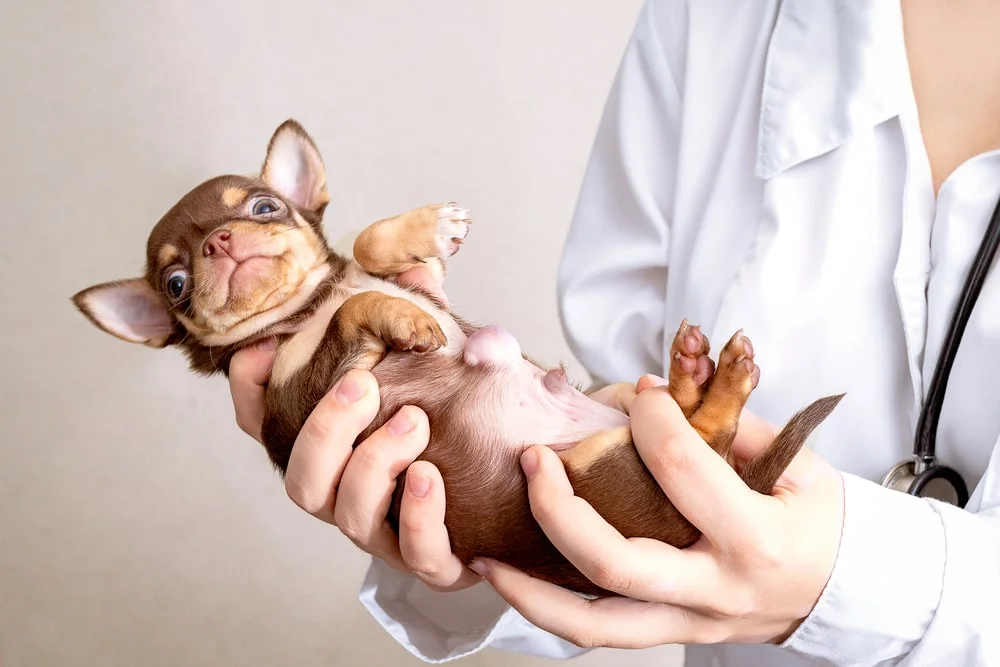PET HEALTH
Dog hernias can be congenital — appearing at birth — or caused by a traumatic injury or straining. Treatment typically requires surgery and the costs can reach over $2,000, depending on a few factors.1
However, dog insurance could help you cover some of these expenses. Let’s take a look at dog hernia surgery costs, the types of hernias dogs can get, and what you can expect from hernia surgery.
MetLife Pet Can Help You Cover Dog Hernia Costs
Enroll Your Pup Today
How Much Does a Dog Hernia Operation Cost?
Fixing most hernias involves an operation. The cost of hernia surgery in dogs can be around $150 for a minor operation, but more complicated surgeries could reach over $2,000. Your exact hernia treatment cost depends on the complexity of the hernia and other factors, including:1
- Diagnostic tests
- Anesthesia
- All surgeries performed (if combining with another procedure)
- Overnight hospitalization
- Vet-prescribed medications
- Follow-up appointments
To help make these costs more accessible, MetLife Pet Insurance offers coverage for dog hernia diagnosis and treatment — like necessary surgery. You could be reimbursed up to 90% on covered costs, making your vet bill a little less stress-inducing.2
What Is a Hernia?
A hernia is a medical condition where an organ or other internal body part pushes through an opening in muscle or tissue into another part of the body. The muscle or tissue is supposed to keep everything in place, but fails when a hernia happens. Let’s take a look at some of the most common hernias found in dogs.
Diaphragmatic hernia
The diaphragm is a muscle in your dog's chest that keeps the contents of the abdomen and chest separate. When the diaphragm tears, abdominal fluids and organs — like the stomach, liver, and intestines — can enter the chest cavity. This can compress the lungs and aggravate the heart, causing difficulty breathing and other problems.3
Diaphragmatic hernias mostly occur from blunt force trauma, and congenital types are less common. Cocker spaniels and Weimaraners may be more prone to congenital diaphragmatic hernias.3
Hiatal hernia
The hiatus is the opening in the diaphragm where the esophagus and stomach connect. A hiatal hernia occurs when the muscles around this opening weaken and the stomach protrudes into the chest cavity. Although it’s a type of diaphragmatic hernia, hiatal hernias tend to be congenital more than they’re caused by trauma. Bulldogs and shar-peis have a higher risk of being born with them.4
Hiatal hernias that develop after birth typically happen because the pressure in the abdomen is greater than the pressure in the chest cavity. Brachycephalic dog breeds can be more prone to these hiatal hernias.4
Umbilical hernia
The umbilical ring is an opening in the abdominal muscles of a developing fetus where the umbilical cord connects. If the umbilical ring on the puppy doesn’t fully close after birth, it can cause an umbilical hernia. Abdominal organs can bulge through the unsealed muscle, causing a soft swelling around the belly button. Umbilical hernias can be reducible, meaning a vet might be able to push the hernia back into the abdomen.5
This type of hernia usually doesn't pose major health risks and isn’t painful. But sometimes intestines can become stuck, and the blood flow is cut off. This can cause tissue death and requires prompt medical attention.5
Inguinal hernia
The inguinal ring is an abdominal wall opening near the pelvis. If this ring is weak and widens, the contents of the abdomen can slip through into the groin area, causing an inguinal hernia.6
Inguinal hernias may be present at birth or acquired with age. Those that develop later in life are often found in intact, toy-breed females, since estrogen may weaken the tissues, and pregnancies can stretch the inguinal ring. Congenital inguinal hernias are more likely to occur in small-breed male dogs.6
Perineal hernia
The perineum is the boundary between the anus and scrotum or vulva that keeps the pelvic organs supported. In humans, we call this the pelvic floor. A perineal hernia happens when this area weakens or tears, letting the bladder, intestines, or fat push through. This kind of hernia mostly happens in older, unneutered male dogs.7
You’ll usually see a soft bulge on one side of your dog’s anus. As with umbilical hernias, a vet may be able to push the hernia back into the body.7
Dog Hernia Symptoms
Dogs with hernias may show a variety of symptoms, depending on the type they have and how severe it is. Some signs can include:3,4,5,6,7
- A visible bulge or swelling
- Difficulty breathing
- Vomiting or regurgitation
- Loss of appetite
- Lethargy
- Struggling to defecate or urinate
- Abnormal heartbeat
- Excessive drooling
Vets may use a visual exam as well as bloodwork, X-rays, and ultrasounds to diagnose the type of hernia your pup has. This can also help them see if there are underlying conditions involved. It’s important to get your dog checked out because severe hernias may lead to tissue death and infection.
Dog Hernia Surgery and Other Treatments
Reducible hernias may not need surgery because the muscle tissue can be pressed back into place, giving the body a chance to close the hernia on its own.5 Your vet may still recommend surgery to keep the hernia from recurring.
Most hernias are non-reducible, meaning they need to be surgically corrected. Once your dog is sedated, your vet will position any herniated organs back where they belong and remove any dead tissue. Tears and holes can then be repaired, sometimes with a patch or mesh closure, so a hernia is less likely to happen again.6,7
Any other damage or health conditions that may have created the hernia or developed as a result of the hernia will also be addressed during treatment. If a diaphragmatic hernia was caused by severe trauma, your vet may need to perform an emergency thoracentesis to clear the chest cavity of fluids.3
When fixing a hernia, vets may recommend spaying or neutering your dog if they haven’t had that procedure yet — especially with umbilical or perineal hernias. In these cases, your vet may do both procedures at once.5,7
Dog hernia surgery recovery
Many dogs have a good prognosis following surgical repair of hernias. Umbilical, inguinal, and perineal hernias that were repaired with surgery typically have a low risk of recurring.5,6,7 But because both diaphragmatic and hiatal hernias can affect the heart and lungs, vets may closely monitor your dog for additional problems that can develop following surgery.3,4
MetLife Pet Can Help You Cover Dog Hernia Surgery Costs
Dog insurance may help you cover costs associated with treating hernias. And MetLife Pet’s optional Preventive Care plan could provide coverage for spaying and neutering, up to your plan’s limit.
Parker, the 4-year-old bichon frise, underwent diagnostics and necessary surgery to repair his hernia. The total vet bill was around $1,150, but Parker’s family was reimbursed close to $950 because of his MetLife Pet policy!8
Get a free quote today to see your personalized rates and enroll your furry companion.


